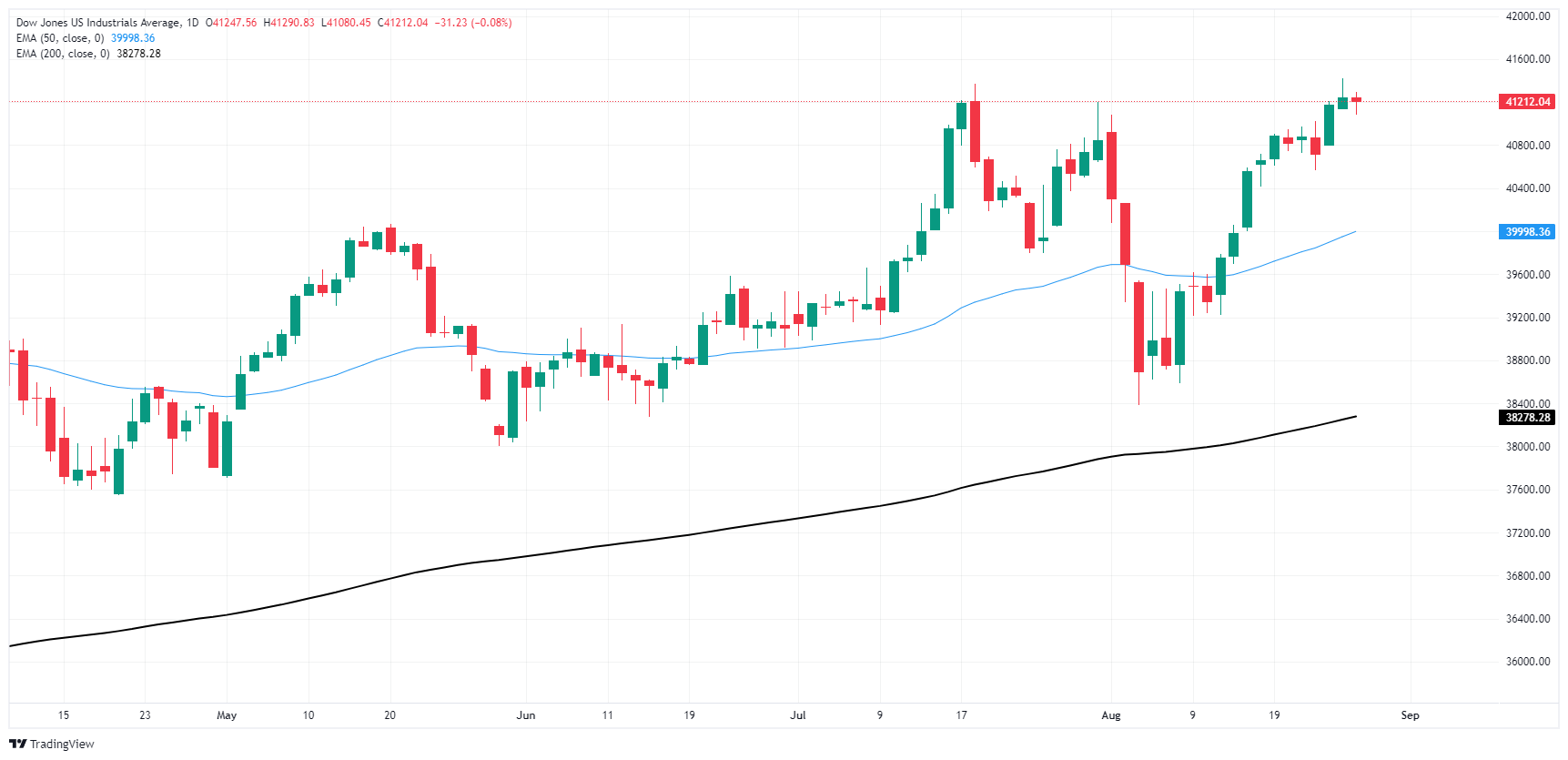Dow Jones Industrial Average eases back on Tuesday as investors take a breather
- The Dow Jones index softened on Tuesday after reaching fresh record highs this week.
- Mixed housing figures gave markets little to chew on as traders await rate cuts.
- US PCE print due at the end of the week marks a critical read on inflation.
The Dow Jones Industrial Average (DJIA) was softer on Tuesday, testing the lower side of the day’s opening bids after clipping into a fresh record high at the outset of the trading week. Market action on the Dow Jones has pulled into the midrange with market bets of a Federal Reserve (Fed) rate cut in September fully priced in. The long wait to the next Fed rate call will be filled with grappling over whether it will be 25 bps or 50.
Fed Chair Jerome Powell all but confirmed that the central bank will pivot into a rate-cutting cycle on September 18 during an appearance at the Jackson Hole Economic Symposium last Friday, sending market appetite into the ceiling and pinning equities into a fresh bullish bid.
Mixed prints in US housing price data from June gave investors little to go on. The Federal Housing Finance Agency’s MoM Housing Price Index contracted -0.1% compared to May’s print of 0.0%. Markets expected a print of 0.2%. The S&P/Case-Shiller Home Price Indices, meanwhile, rose 6.5% YoY, less than the previous period’s revised 6.9%, but still more than the expected 6.0%.
US Q2 Gross Domestic Product (GDP) figures are slated to print on Thursday, and are expected to hold steady at 2.8% on an annualized basis. However, the key data print this week will be Friday’s US Personal Consumption Expenditure (PCE) Price Index inflation reading for July, which is expected to tick higher YoY to 2.7% from 2.6% and hold flat at 0.2% MoM. Market participants absolutely giddy over hopes for rate cuts will be looking for inflation data to come in below expectations, while an above-forecast print could send fresh jitters through investor risk appetite.
Dow Jones news
Despite an overall softer tone on Tuesday, the Dow Jones is roughly on-balance heading into the midweek. Half of the DJIA board is in the green, with the other half easing back slightly. Nike (NKE) rose 1.1% to $85.20 per share, while Amazon (AMZN) backslid 1.08% to $173.61 per share.
Dow Jones price forecast
The Dow Jones is trading flat on Tuesday, with some early exploration into the downside. The major equity index tested lower, but still remains well-bid above 41,000.00 and is sticking close to record highs set this week at 41,419.65.
The next immediate roadblock for bidders hopeful to re-establish bullish momentum will be a firm break of the 41,500.00 round number barrier. Despite a potential slowdown forming on the daily candlesticks, short sellers will have their work cut out for them trying to drag price action down to the nearest meaningful technical barrier at the 50-day Exponential Moving Average (EMA) rising into the 40,000.00 major handle.
Dow Jones daily chart

Dow Jones FAQs
The Dow Jones Industrial Average, one of the oldest stock market indices in the world, is compiled of the 30 most traded stocks in the US. The index is price-weighted rather than weighted by capitalization. It is calculated by summing the prices of the constituent stocks and dividing them by a factor, currently 0.152. The index was founded by Charles Dow, who also founded the Wall Street Journal. In later years it has been criticized for not being broadly representative enough because it only tracks 30 conglomerates, unlike broader indices such as the S&P 500.
Many different factors drive the Dow Jones Industrial Average (DJIA). The aggregate performance of the component companies revealed in quarterly company earnings reports is the main one. US and global macroeconomic data also contributes as it impacts on investor sentiment. The level of interest rates, set by the Federal Reserve (Fed), also influences the DJIA as it affects the cost of credit, on which many corporations are heavily reliant. Therefore, inflation can be a major driver as well as other metrics which impact the Fed decisions.
Dow Theory is a method for identifying the primary trend of the stock market developed by Charles Dow. A key step is to compare the direction of the Dow Jones Industrial Average (DJIA) and the Dow Jones Transportation Average (DJTA) and only follow trends where both are moving in the same direction. Volume is a confirmatory criteria. The theory uses elements of peak and trough analysis. Dow’s theory posits three trend phases: accumulation, when smart money starts buying or selling; public participation, when the wider public joins in; and distribution, when the smart money exits.
There are a number of ways to trade the DJIA. One is to use ETFs which allow investors to trade the DJIA as a single security, rather than having to buy shares in all 30 constituent companies. A leading example is the SPDR Dow Jones Industrial Average ETF (DIA). DJIA futures contracts enable traders to speculate on the future value of the index and Options provide the right, but not the obligation, to buy or sell the index at a predetermined price in the future. Mutual funds enable investors to buy a share of a diversified portfolio of DJIA stocks thus providing exposure to the overall index.


